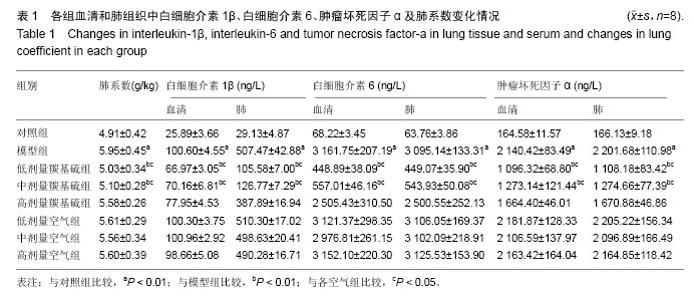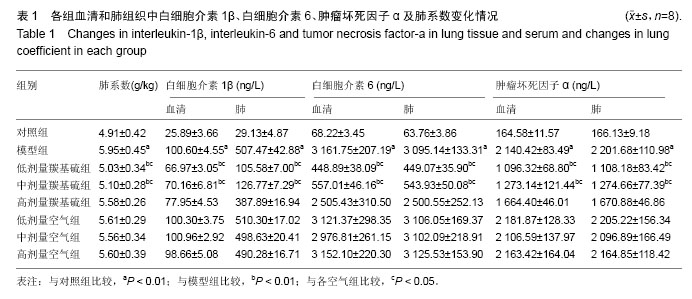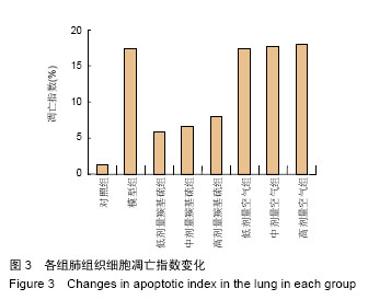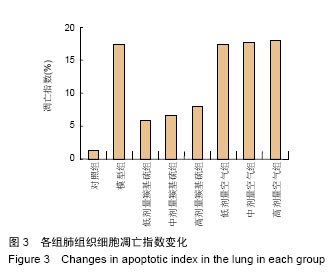Chinese Journal of Tissue Engineering Research ›› 2016, Vol. 20 ›› Issue (40): 5994-6000.doi: 10.3969/j.issn.2095-4344.2016.40.010
Previous Articles Next Articles
Effects of carbonyl sulfide in a rat model of limb ischemia/reperfusion-induced acute lung injury
Zhao Yan-rui, Lv Wen-rui, Wang Dong, Zhou Jun-lin
- Department of Orthopedics, Beijing Chao-Yang Hospital, Capital Medical University, Beijing 100020, China
-
Revised:2016-07-11Online:2016-09-30Published:2016-09-30 -
Contact:Zhou Jun-lin, Chief physician, Department of Orthopedics, Beijing Chao-Yang Hospital, Capital Medical University, Beijing 100020, China -
About author:Zhao Yan-rui, Studying for doctorate, Department of Orthopedics, Beijing Chao-Yang Hospital, Capital Medical University, Beijing 100020, China
CLC Number:
Cite this article
Zhao Yan-rui, Lv Wen-rui, Wang Dong, Zhou Jun-lin. Effects of carbonyl sulfide in a rat model of limb ischemia/reperfusion-induced acute lung injury[J]. Chinese Journal of Tissue Engineering Research, 2016, 20(40): 5994-6000.
share this article
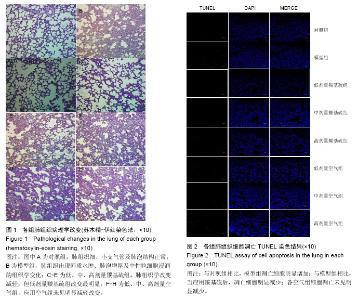
2.1 实验动物死亡率 实验过程中,对照组、模型组及不同剂量空气组无实验动物死亡,存活率为100%。低剂量羰基硫组无实验动物死亡,中剂量羰基硫组死亡2只,死亡率为25%;高剂量羰基硫组死亡3只,死亡率为38%。 2.2 各组肺组织形态学变化 光镜下观察可见对照组大鼠肺组织细、小支气管及肺泡结构正常,支气管黏膜上皮完整,见图1A;模型组肢体缺血4 h再灌注2 h后,肺组织出现间质水肿、肺泡增厚及中性粒细胞浸润的组织学变化,见图1B;应用羰基硫后(0.2,0.5,1 mL)肺组织学改变减轻,但低剂量羰基硫组改变最明显,见图1C-E;应用空气组未见明显减轻改变,见图1 F-H。 2.3 各组肺系数的变化 与对照组相比,模型组肺系数显著增大(P < 0.01);与模型组相比,羰基硫组均有改变,以低剂量羰基硫组肺系数改变最明显(P < 0.01),高剂量羰基硫组改变较小;不同剂量空气组未见明显改变(P > 0.05);与各剂量空气各组相比,各剂量羰基硫组(0.2,0.5 mL)肺系数改变明显(P < 0.01),见表1。 2.4 各组肺组织及血浆中细胞因子水平的变化 与对照组相比,模型组肺组织及血浆中白细胞介素1β、白细胞介素6和肿瘤坏死因子α含量均明显增加(P < 0.01)。与模型组相比,低、中剂量羰基硫组肺组织及血浆中的白细胞介素1β、白细胞介素6和肿瘤坏死因子α含量明显减少(P < 0.01),高剂量羰基硫组改变不明显;各空气组肺组织及血浆中的白细胞介素1β、白细胞介素6和肿瘤坏死因子α含量无明显变化(P > 0.05)。与各空气组相比,低、中剂量羰基硫组肺组织及血浆中的白细胞介素1β、白细胞介素6和肿瘤坏死因子α含量明显减少(P < 0.01),见表1。 2.5 各组TUNEL检测结果 对照组中仅见少量凋亡细胞,凋亡指数为1.47%。与对照组相比,模型组凋亡细胞明显增加,凋亡指数达17.2%;与模型组相比,当应用羰基硫后,凋亡细胞明显减少,低、中、高剂量羰基硫组凋亡指数分别为5.83%、6.48%、7.88%;各空气组细胞凋亡未见明显减少,低、中、高剂量空气组凋亡指数分别为17.25%、17.65%、17.85%,见图2,3。"
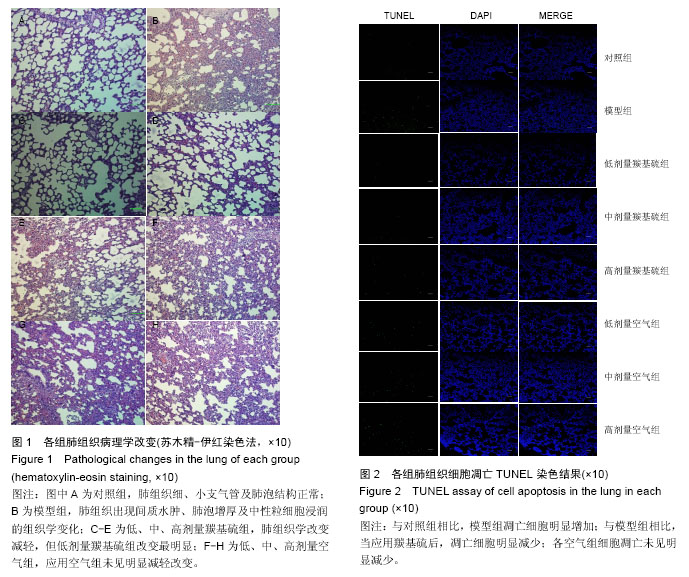
| [1] 周君琳,凌亦凌,苏庆军,等.外源性一氧化碳抗大鼠肢体缺血再灌注所致肺损伤的实验研究[J].中国病理生理杂志, 2006,22(2):303-306. [2] Atabai K,Matthay MA.The pulmonary physician in critical care-5: acute lung injury and the acute respiratory distress syndrome:definitions and epidemiology. Thorax. 2002;57:452-458. [3] Li L,Moore PK.An overview of the biological significance of endogenous gases: new roles for old molecules.Biochem Soc Trans.2007;35:1138-1141. [4] Moody BF,Calvert JW.Emergent role of gasotransmitters in ischemia-reperfusion injury. Medical Gas Res.2011;1:3. [5] Zhao YR,Wang D,Liu Y,et al.The PI3K/Akt, p38MAPK, and JAK2/STAT3 Signaling Pathways Mediate the Protection of SO2 Against Acute Lung Injury Induced by Limb Ischemia/Reperfusion in Rats.J Physiol Sci. 2016;66(3):229-239.. [6] 赵彦瑞,刘洋,王东,等.PI3K/Akt和JAK2/STAT3信号转导通路在SO2抗大鼠肢体缺血再灌注致急性肺损伤中的作用[J].中国病理生理杂志,2015,31(11):2076-2082. [7] Huang XL,Liu Y,Zhou JL,et al.Role of Sulfur Dioxide in Acute Lung Injury Following Limb Ischemia /Rep erfusion in Rats.J Biochem Mol Toxicol.2013;27(8):389-397. [8] 周君琳,黄新莉,黎宁,等.二氧化硫对大鼠肢体缺血再灌注所致肺损伤的影响及其作用机制[J].中国病理生理杂志, 2013,29(10):1747-1752. [9] 杨运彩,周君琳,黄新莉,等.一氧化碳释放分子对肢体缺血-再灌注所致肺损伤的作用[J].中华急诊医学杂志,2012, 21(1):43-47. [10] 周君琳,黄新莉,仲维佳,等.硫化氢对肢体缺血再灌注所致大鼠急性肺损伤的作用及机制[J].中国病理生理杂志, 2011,27(1):9-13. [11] 刘洋,单磊,周君琳,等.MAPKs在硫化氢抗大鼠肢体缺血再灌注所致肺损伤中的作用[J].昆明医学院学报,2011, 32(9):16-20. [12] Zhou JL,Li G,Hai Y,et al.Protection of CO-rel easing molecule against lung injury induced by limb ischemia- reperfusion.Chin J Traumatol.2009;12(2):71-76. [13] 周君琳,凌亦凌,李陈利,等.一氧化氮和过氧亚硝基阴离子在肢体缺血再灌注致肺损伤中的作用[J].中国病理生理杂志,2003,24(6):158-160. [14] 周君琳,凌亦凌,鲁士宝,等.丝裂原活化蛋白激酶在一氧化碳抗大鼠肢体缺血再灌注所致肺损伤中的作用[J].中华实验外科杂志,2005,22(2):163-165. [15] Bloch KD,Ichinose F,Roberts JJ,et al.Inhaled NO as a therapeutic agent. Cardiovasc Res.2007;75:339-348. [16] Afshari A,Brok J,Moller AM,et al.Inhaled nitric oxide for acute respiratory distress syndrome (ARDS) and acute lung injury in children and adults. Cochrane Database Syst Rev.2010;(7):CD002787. [17] Ryter SW,Choi AM.Heme oxygenase-1/carbon monoxide: novel therapeutic strategies in critical care medicine.Curr Drug Targets.2010;11:1485-1494. [18] Ren Y.Natural occurrence of carbonyl sulfide and ethyl formate in grains.In Proceedings of the International Conference on Controlled Atmosphere and Fumigation in Stored Products,2002. [19] Balazy M,Abu-Yousef IA,Harpp DN,et al.Identification of carbonyl sulfide and sulfur dioxide in porcine coronary artery by gas chromatography/mass spectrometry, possible relevance to EDHF.Biochem Biophys Res Commun.2003;311(3):728-734. [20] Cohen SM,Siddiqi FA,Darakchiev B,et al.Attenuation of acute lung injury caused by hind-limb ischemia- reperfusion injury by butyrolactone anti-inflammatory agent FLl003.J Trauma. 1997;43(2):247-252. [21] Lardinois1 Q,Kirby PJ,Morgan DL,et al.Mass spectrometric analysis of rat cerebrospinal fluid proteins following exposure to the neurotoxicant carbonyl sulfide.Rapid Commun.Mass Spectrom. 2014; 28:2531-2538. [22] 刘俊锋,耿春梅,牟玉静,等.羰基硫(COS)在土壤中的吸收与转化[J].环境化学,2004, 23(6):615-620. [23] 牟玉静,周丽,张晓山,等.羰基硫(COS)在麦田土壤中的地气交换[J].中国科学(B辑 化学),2001,1(3):261-264. [24] 聂亚峰,席淑琪,张晋华,等.环境因素对土壤含硫气体释放的影响[J].环境化学,2001, 20(1):38-42. [25] 刘俊锋,耿春梅,张逸,等.羰基硫(COS)在五种富氧型土壤中的吸收与转化[J].环境化学, 2011,30(3):579-584. [26] 王冠,孙同华,张宏波,等.催化水解法低温脱除煤气中羰基硫的研究[J].现代化工,2014, 34(1):60-63. [27] 沈芳,上官炬,樊惠玲.工艺条件对中温羰基硫水解催化转化率的影响[J].太原理工大学学报,2009,40(1):32-34. [28] 范健,雷军.COS脱除技术进展[J].安徽化工,2007,33(4): 3-5. [29] 柯明,许赛威,刘成翠,等.常温羰基硫水解催化剂的研究进展[J].石油与天然气化工,2007,36(4):271-274. [30] 李新学,刘迎新,魏雄辉.羰基硫脱除技术[J].现代化工 ,2004,24(8):19-22. [31] Katayama Y,Narahara Y,Inoue Y,et al.A thiocyanate hydrolase of Thiobacillus thioparus. A novel enzyme catalyzing the formation of carbonyl sulfide from thiocyanate, J Biol Chem.1992;267:9170-9175. [32] Vlasceanu L,Popa R,Kinkle BK.Characterization of Thiobacillus thioparus LV43 and its distribution in a chemoautotrophically based groundwater ecosystem.Appl Environ Microbiol. 1997;63: 3123-3127. [33] Schultz CP,Ahmed MK,Dawes C,et al.Thiocyanate levels in human saliva: quantitation by Fourier transform infrared spectroscopy.Anal Biochem. 1996;240:7-12. [34] Spagnolo A,Torsello S,Morisi G,et al.Serum thiocyanate levels as an objective measure of smoking habits in epidemiological studies.Eur J Epidemiol. 1988;4(2):206-211. [35] Zheng T,Altura BT,et al.Magnesium modulates contractile responses of rat aorta to thiocyanate: a possible relationship to smoking-induced atherosclerosis.Toxicol Appl Pharmacol.1999; 157:77-84. [36] Kelly DP, Wood AP, Iordan SL, et al.Biological production and consumption of gaseous organic sulphur compounds.Biochem Soc Trans.1994; 22: 1011-1015. [37] Chengelis CP,Neal RA.Studies of Carbonyl Sulfide Toxicity: Metabolism by Carbonic Anhydrasel.Toxicol Appl Pharm.1980;55:198-202. [38] Morgan DL,Little PB,Herr DW,et al.Neurotoxicity of carbonyl sulfide in F344 rats following inhalation exposure for up to 12 weeks.Toxicol Appl Pharmacol. 2004;200:131. [39] Morrison JP,Ton TV,Collins JB, et al.Gene expression studies reveal that DNA damage, vascular perturbation, and inflammation contribute to the pathogenesis of carbonyl sulfide neurotoxicity.Toxicol Pathol.2009; 37: 502. [40] Sills RC,Morgan DL,Herr DW,et al.Contribution of magnetic resonance microscopy in the 12-week neurotoxicity evaluation of carbonyl sulfide in Fischer 344 rats.Toxicol Pathol.2004;32:501. [41] Lardinois O,Kirby PJ,Morgan DL,et al.Mass spectrometric analysis of rat cerebrospinal fluid proteins following exposure to the neurotoxicant carbonyl sulfide. Rapid Commun Mass Spectrom. 2014;28(23):2531-2538. |
| [1] | Shi Bin, An Jing, Chen Long-gang, Zhang Nan, Tian Ye . Influencing factors for pain after total knee arthroplasty [J]. Chinese Journal of Tissue Engineering Research, 2017, 21(7): 993-997. |
| [2] | Wang Xian-xun. Impact of local compression cryotherapy combined with continuous passive motion on the early functional recovery after total knee arthroplasty [J]. Chinese Journal of Tissue Engineering Research, 2017, 21(7): 998-1003. |
| [3] | Yuan Wei, Zhao Hui, Ding Zhe-ru, Wu Yu-li, Wu Hai-shan, Qian Qi-rong. Association between psychological resilience and acute mental disorders after total knee arthroplasty [J]. Chinese Journal of Tissue Engineering Research, 2017, 21(7): 1015-1019. |
| [4] | Chen Qun-qun, Qiao Rong-qin, Duan Rui-qi, Hu Nian-hong, Li Zhao, Shao Min. Acu-Loc®2 volar distal radius bone plate system for repairing type C fracture of distal radius [J]. Chinese Journal of Tissue Engineering Research, 2017, 21(7): 1025-1030. |
| [5] | Huang Xiang-wang, Liu Hong-zhe. A new low elastic modulus of beta titanium alloy Ti2448 spinal pedicle screw fixation affects thoracic stability: biomechanical analysis [J]. Chinese Journal of Tissue Engineering Research, 2017, 21(7): 1031-1035. |
| [6] | Xie Qiang. Three-dimensional finite element model for biomechanical analysis of stress in knee inversion and external rotation after posterior cruciate ligament rupture [J]. Chinese Journal of Tissue Engineering Research, 2017, 21(7): 1036-1040. |
| [7] | He Ze-dong, Zhao Jing, Chen Liang-yu, Li Ke, Weng Jie. Multilevel finite element analysis on the biological tribology damage of water on bone tissue [J]. Chinese Journal of Tissue Engineering Research, 2017, 21(7): 1041-1045. |
| [8] | Jiang Zi-wei, Huang Feng, Cheng Si-yuan, Zheng Xiao-hui, Sun Shi-dong, Zhao Jing-tao, Cong Hai-chen,Sun Han-qiao, Dong Hang. Design and finite element analysis of digital splint [J]. Chinese Journal of Tissue Engineering Research, 2017, 21(7): 1052-1056. |
| [9] | Wang Fei, Liu Zhi-bin, Tao Hui-ren, Zhang Jian-hua, Li Chang-hong, Cao Qiang, Zheng Jun, Liu Yan-xiong, Qu Xiao-peng. Clinical efficacy of preoperative osteotomy designs using paper-cut technology versus photoshop software for ankylosing spondylitis with kyphosis [J]. Chinese Journal of Tissue Engineering Research, 2017, 21(7): 1057-1063. |
| [10] | Li Hui, Ma Jun-yi, Ma Yuan, Zhu Xu . Establishment of a three-dimensional finite element model of ankylosing spondylitis kyphosis [J]. Chinese Journal of Tissue Engineering Research, 2017, 21(7): 1069-1073. |
| [11] | Ling Guan-han, Ou Zhi-xue, Yao Lan, Wen Li-chun, Wang Guo-xiang, Lin Heng-feng. Establishment of simulating three-dimensional model of China-Japan Friendship Hospital Classification for L type osteonecrosis of the femoral head [J]. Chinese Journal of Tissue Engineering Research, 2017, 21(7): 1074-1079. |
| [12] | Fu Wei-min, Wang Ben-jie. Assessing the degree of necrotic femoral head, and association of blood supply with pathlogical changes: study protocol for a diagnostic animal trial [J]. Chinese Journal of Tissue Engineering Research, 2017, 21(7): 1086-1091. |
| [13] | Zhang Wen-qiang, Ding Qian, Zhang Na. Associations between alpha angle and herniation pit on oblique axial magnetic resonance imaging in asymptomatic hip joints of adults [J]. Chinese Journal of Tissue Engineering Research, 2017, 21(7): 1098-1103. |
| [14] | Sun Xiao-xin1, Zhou Wei2, Zuo Shu-ping3, Liu Hao1, Song Jing-feng1, Liang Chun-yu1. Morphological characteristics for the magnetic resonance imaging assessment of discoid lateral meniscal tears in children [J]. Chinese Journal of Tissue Engineering Research, 2017, 21(7): 1104-1109. |
| [15] | Lin Han-wen, Wen Jun-mao, Huang Chao-yuan, Zhou Chi, Tang Hong-yu. Correlation between the changes in lower limb power line and pain area in the knee osteoarthritis patients: imaging evaluation [J]. Chinese Journal of Tissue Engineering Research, 2017, 21(7): 1110-1114. |
| Viewed | ||||||
|
Full text |
|
|||||
|
Abstract |
|
|||||
